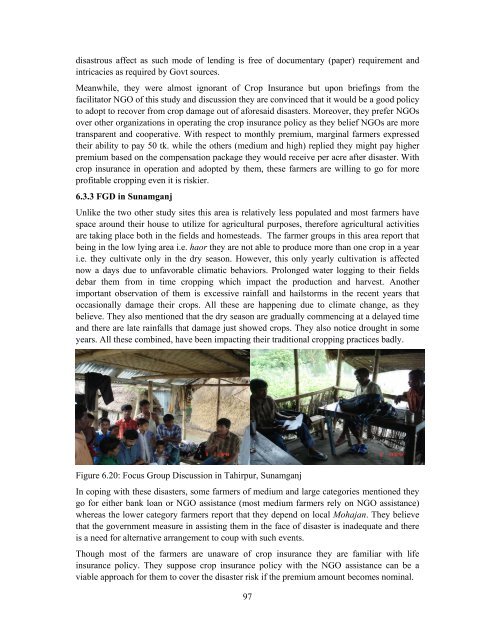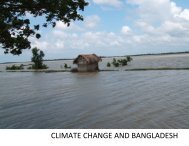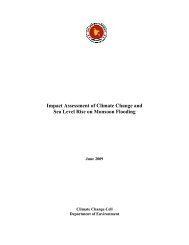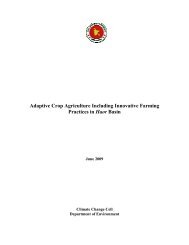Crop Insurance as a Risk Management Strategy in Bangladesh
Crop Insurance as a Risk Management Strategy in Bangladesh
Crop Insurance as a Risk Management Strategy in Bangladesh
Create successful ePaper yourself
Turn your PDF publications into a flip-book with our unique Google optimized e-Paper software.
dis<strong>as</strong>trous affect <strong>as</strong> such mode of lend<strong>in</strong>g is free of documentary (paper) requirement and<br />
<strong>in</strong>tricacies <strong>as</strong> required by Govt sources.<br />
Meanwhile, they were almost ignorant of <strong>Crop</strong> <strong>Insurance</strong> but upon brief<strong>in</strong>gs from the<br />
facilitator NGO of this study and discussion they are conv<strong>in</strong>ced that it would be a good policy<br />
to adopt to recover from crop damage out of aforesaid dis<strong>as</strong>ters. Moreover, they prefer NGOs<br />
over other organizations <strong>in</strong> operat<strong>in</strong>g the crop <strong>in</strong>surance policy <strong>as</strong> they belief NGOs are more<br />
transparent and cooperative. With respect to monthly premium, marg<strong>in</strong>al farmers expressed<br />
their ability to pay 50 tk. while the others (medium and high) replied they might pay higher<br />
premium b<strong>as</strong>ed on the compensation package they would receive per acre after dis<strong>as</strong>ter. With<br />
crop <strong>in</strong>surance <strong>in</strong> operation and adopted by them, these farmers are will<strong>in</strong>g to go for more<br />
profitable cropp<strong>in</strong>g even it is riskier.<br />
6.3.3 FGD <strong>in</strong> Sunamganj<br />
Unlike the two other study sites this area is relatively less populated and most farmers have<br />
space around their house to utilize for agricultural purposes, therefore agricultural activities<br />
are tak<strong>in</strong>g place both <strong>in</strong> the fields and homesteads. The farmer groups <strong>in</strong> this area report that<br />
be<strong>in</strong>g <strong>in</strong> the low ly<strong>in</strong>g area i.e. haor they are not able to produce more than one crop <strong>in</strong> a year<br />
i.e. they cultivate only <strong>in</strong> the dry se<strong>as</strong>on. However, this only yearly cultivation is affected<br />
now a days due to unfavorable climatic behaviors. Prolonged water logg<strong>in</strong>g to their fields<br />
debar them from <strong>in</strong> time cropp<strong>in</strong>g which impact the production and harvest. Another<br />
important observation of them is excessive ra<strong>in</strong>fall and hailstorms <strong>in</strong> the recent years that<br />
occ<strong>as</strong>ionally damage their crops. All these are happen<strong>in</strong>g due to climate change, <strong>as</strong> they<br />
believe. They also mentioned that the dry se<strong>as</strong>on are gradually commenc<strong>in</strong>g at a delayed time<br />
and there are late ra<strong>in</strong>falls that damage just showed crops. They also notice drought <strong>in</strong> some<br />
years. All these comb<strong>in</strong>ed, have been impact<strong>in</strong>g their traditional cropp<strong>in</strong>g practices badly.<br />
Figure 6.20: Focus Group Discussion <strong>in</strong> Tahirpur, Sunamganj<br />
In cop<strong>in</strong>g with these dis<strong>as</strong>ters, some farmers of medium and large categories mentioned they<br />
go for either bank loan or NGO <strong>as</strong>sistance (most medium farmers rely on NGO <strong>as</strong>sistance)<br />
where<strong>as</strong> the lower category farmers report that they depend on local Mohajan. They believe<br />
that the government me<strong>as</strong>ure <strong>in</strong> <strong>as</strong>sist<strong>in</strong>g them <strong>in</strong> the face of dis<strong>as</strong>ter is <strong>in</strong>adequate and there<br />
is a need for alternative arrangement to coup with such events.<br />
Though most of the farmers are unaware of crop <strong>in</strong>surance they are familiar with life<br />
<strong>in</strong>surance policy. They suppose crop <strong>in</strong>surance policy with the NGO <strong>as</strong>sistance can be a<br />
viable approach for them to cover the dis<strong>as</strong>ter risk if the premium amount becomes nom<strong>in</strong>al.<br />
97





